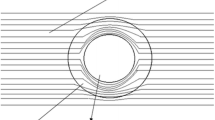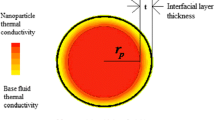Abstract
An ordered liquid layer around the particle–liquid interface is called as interfacial layer. It has been observed that interfacial layer is an essential parameter for determining the effective thermal conductivity of nanofluids. The review attempts to summarize the prominent articles related to interfacial layer effect on the thermal conductivity of nanofluids. First section of the paper discusses about various experimental approaches used to describe the effect of interfacial layer. Second section deals with about the mathematical models and assumed values regarding the thickness of interfacial layer by several authors. A review of previous works featuring mathematical investigations and experimental approaches seem to be suggesting that, interfacial layer have dominating effect on the effective thermal conductivity of the nanofluids. Third section of the paper deals with various mathematical models available in open literature for interfacial layer thermal conductivity. In the last section, models for effective thermal conductivity of the nanofluids considering the interfacial layer and percentage deviations in the predictions of mathematical models have been discussed.






Similar content being viewed by others
Abbreviations
- r p :
-
Particle radius
- ρ :
-
Density
- ∇:
-
Divergence
- t :
-
Thickness of interfacial layer
- α :
-
Coefficient in thermal conductivity
- ϕ :
-
Volume fraction
- N A :
-
Avogadro constant
- M f :
-
Molecular weight of liquid
- k :
-
Thermal conductivity
- agg :
-
Aggregating particles
- c :
-
Combined nanoparticles
- cl :
-
Particle cluster
- e :
-
Equivalent particle
- eff :
-
Effective
- f :
-
Base fluid
- l :
-
Interfacial layer
- m :
-
Power law exponent
- non-agg :
-
Non-aggregating particles
- p :
-
Particle
- r :
-
Variable radius
References
Maxwell JC (1881) A treatise on electricity and magnetism, 2nd edn. Clarendon Press, Oxford, pp 435–441
Choi SUS, Eastman JA (1995) Enhancing thermal conductivity of fluids with nanoparticles. ASME Int Mech Eng Congr Expos 66:99–105
Wang XQ, Mujumdar AS (2008) A review on nanofluids—part I: theoretical and numerical investigations. Braz J Chem Eng 25(4):613–630
Masuda H, Ebata A, Teramae K, Hishinuma N (1993) Alteration of thermal conductivity and viscosity of liquid by dispersing ultra-fine particles (dispersion and Al2O3, SiO2, and TiO2 ultra-fine particles). Netsu Bussei 7(4):227–233
Eastman JA, Choi SUS, Li S, Thompson LJ, Lee S (1997) Enhanced thermal conductivity through the development of nanofluids. Mater Res Soc Symp Proc 457:3–11
Lee S, Choi SUS, Li S, Eastman JA (1999) Measuring thermal conductivity of fluids containing oxide nanoparticles. J Heat Transf 121(2):280–289
Tillman P, Hill JM (2007) Determination of nanolayer thickness for a nanofluid. Int Commun Heat Mass Transf 34(4):399–407
Kumar DH, Patel HE, Kumar VRR, Sundararajan T, Pradeep T, Das SK (2004) Model for heat conduction in nanofluids. Phys Rev Lett 93(14):144301(1-4)
Evans W, Prasher R, Fish J, Meakin P, Phelan P, Keblinski P (2008) Effect of aggregation and interfacial thermal resistance on thermal conductivity of nanocomposites and colloidal nanofluids. Int J Heat Mass Transf 51(5–6):1431–1438
Paul G, Philip J, Raj B, Das PK, Manna I (2011) Synthesis, characterization, and thermal property measurement of nano-Al95Zn05 dispersed nanofluid prepared by a two-step process. Int J Heat Mass Transf 54(15–16):3783–3788
Anoop KB, Sundararajan T, Das SK (2009) Effect of particle size on the convective heat transfer in nanofluid in the developing region. Int J Heat Mass Transf 52(9–10):2189–2195
Chopkar M, Das PK, Manna I (2006) Synthesis and characterization of nanofluid for advanced heat transfer applications. Scr Mater 55(6):549–552
Chon CH, Kihm KD, Lee SP, Choi SUS (2005) Empirical correlation finding the role of temperature and particle size for nanofluid (Al2O3) thermal conductivity enhancement. Appl Phys Lett 87(15):153107–153109
Teng TP, Hung YH, Teng TC, Mo HE, Hsu HG (2010) The effect of alumina/water nanofluid particle size on thermal conductivity. Appl Therm Eng 30(14–15):2213–2218
Chang T-B, Syu S-C, Yang Y-K (2012) Effects of particle volume fraction on spray heat transfer performance of Al2O3-water nanofluid. Int J Heat Mass Transf 55(4):1014–1021
Abareshi M, Goharshadi EK, Zebarjad SM, Fadafan HK, Youssefi A (2010) Fabrication, characterization and measurement of thermal conductivity of Fe3O4 nanofluids. J Magn Magn Mater 322(24):3895–3901
Patel HE, Das SK, Sundarajan T, Nair AS, George B, Pradeep T (2003) Thermal conductivities of naked and monolayer protected metal nanoparticle based nanofluids: Manifestation of anomalous enhancement and chemical effects. Appl Phys Lett 83(14):2931–2933
Xie H, Wang J, Xi T, Liu Y, Ai F, Wu Q (2002) Thermal conductivity enhancement of suspensions containing nanosized alumina particles. J Appl Phys 91(7):4568–4572
Moosavi M, Goharshadi EK, Youssefi A (2010) Fabrication, characterization, and measurement of some physicochemical properties of ZnO nanofluids. Int J Heat Fluid Flow 31(4):599–605
Wang BX, Zhou LP, Peng XF (2003) A fractal model for predicting the effective thermal conductivity of liquid with suspension of nanoparticles. Int J Heat Mass Transf 46(14):2665–2672
Jang SP, Choi SUS (2004) Role of Brownian motion in the enhanced thermal conductivity of nanofluids. Appl Phys Lett 84(21):4316–4318
Xue Q-Z (2003) Model for effective thermal conductivity of nanofluids. Phys Lett A 307(5–6):313–317
Xuan Y, Li Q, Hu W (2003) Aggregation structure and thermal conductivity of nanofluids. AIChE J 49(4):1038–1043
Yu W, Choi SUS (2003) The Role of interfacial layers in the enhanced thermal conductivity of nanofluids: A renovated Maxwell model. J Nanopart Res 5:167–171
Israelachvili JN (2011) Intermolecular and surface forces: revised, 3rd edn. Academic Press, Cambridge
Li L, Zhang Y, Ma H, Yang M (2008) An investigation of molecular layering at the liquid-solid interface in nanofluids by molecular dynamics simulation. Phys Lett A 372:4541–4544
Suganthi KS, Parthasarathy M, Rajan KS (2013) Liquid-layering induced, temperature-dependent thermal conductivity enhancement in ZnO–propylene glycol nanofluids. Chem Phys Lett 561–562:120–124
Cui W, Shen Z, Yang J, Wu S (2016) Molecular dynamics simulation on the microstructure of absorption layer at the liquid–solid interface in nanofluids. Int Commun Heat Mass Transf 71:75–85
Kang H, Zhang Y, Yang M (2011) Molecular dynamics simulation of thermal conductivity of Cu–Ar nanofluid using EAM potential for Cu–Cu interactions. Appl Phys A 103:1001–1008
Xie H, Fujii M, Zhang X (2005) Effect of interfacial nanolayer on the effective thermal conductivity of nanoparticle-fluid mixture. Int J Heat Mass Transf 48(14):2926–2932
Choi SUS, Zhang ZG, Yu W, Lockwood FE, Grulke EA (2001) Anomalous thermal conductivity enhancement in nanotube suspensions. Appl Phys Lett 79(14):2252–2254
Eknath HP (2007) Experimental and theoretical investigation on thermal conductivity enhancement of nanofluids. Ph.D. Thesis, Indian Institute of Technology Madras, India
Prasher R (2009) Acoustic mismatch model for thermal contact resistance of van der Waals contacts. Appl Phys Lett 94:041905(1-3)
Gerardi C, Cory D, Buongiorno J, Hu L-W, Mckrell T (2009) Nuclear magnetic resonance-based study of ordered layering on the surface of alumina nanoparticles in water. Appl Phys Lett 95:253104(1-3)
Neyts EC, Brault P (2016) Molecular dynamics simulations for plasma-surface interactions. Plasma Process Polym. doi:10.1002/ppap.201600145
Hu C, Bai M, Lv J, Wang P, Zhang L, Li X (2014) Molecular dynamics simulation of nanofluid’s flow behaviors in the near-wall model and main flow model. Microfluid Nanofluid 17:581–589
Li L, Zhang Y, Ma H, Yang M (2010) Molecular dynamics simulation of effect of liquid layering around the nanoparticle on the enhanced thermal conductivity of nanofluids. J Nanopart Res 12:811–821
Eapen J, Li J, Yip S (2006) Probing transport mechanisms in nanofluids by molecular dynamics simulations. In: Proceeding of the 18th National and 7th ISHMT–ASME heat and mass transfer conference, IIT Guwahati, India
Sarkar S, Selvam RP (2007) Molecular dynamics simulation of effective thermal conductivity and study of enhanced thermal transport mechanism in nanofluids. J Appl Phys 102:074302(1-7)
Liang Z, Tsai HL (2011) Thermal conductivity of interfacial layers in nanofluids. Phys Rev E 83:041602(1-8)
Xue Q, Xu W-M (2005) A model of thermal conductivity of nanofluids with interfacial shells. Mater Chem Phys 90(2–3):298–301
Yu W, Choi SUS (2004) The role of interfacial layers in the enhanced thermal conductivities of nanofluids: A renovated Hamilton–Crosser model. J Nanopart Res 6(4):355–361
Yu W, Choi SUS (2005) An effective conductivity model of nanofluids with a cubical arrangement of spherical particles. J Nanosci Nanotechnol 5(4):580–586
Ren Y, Xie H, Cai A (2005) Effective thermal conductivity of nanofluids containing spherical nanoparticles. J Phys D Appl Phys 38(21):3958–3961
Yu C-J, Richter AG, Datta A, Durbin MK, Dutta P (1999) Observation of molecular layering in thin films using X-ray reflectivity. Phys Rev Lett 82(11):2326–2329
Rizvi IH, Jain A, Ghosh SK, Mukherjee PS (2013) Mathematical modelling of thermal conductivity for nanofluid considering interfacial nano-layer. Heat Mass Transf 49(4):595–600
Berger F, Dekany I (1998) Variable thickness of the liquid sorption layers on solid surfaces. J Colloids Surf A Physiochem Eng Asp 141(3):305–317
Li ZH, Gong YJ, Pu M, Wu D, Sun YH, Wang J, Liu Y, Dong BZ (2001) Determination of interface layer thickness of a pseudo two-phase system by extension of the Debye equation. J Phys D Appl Phys 34(14):2085–2088
Murshed SMS, Leong KC, Yang C (2008) Investigations of thermal conductivity and viscosity of nanofluids. Int J Therm Sci 47(5):560–568
Kamalvand M, Karami M (2013) A linear regularity between thermal conductivity enhancement and fluid adsorption in nanofluids. Int J Therm Sci 65:189–195
Keshavazi E, Kamalvand M (2009) Energy effect on the structure and thermodynamic properties of nanoconfined fluids (a density functional theory study). J Phys Chem B 113(16):5493–5499
Tso CY, Fu SC, Chao CYH (2014) A semi-analytical model for the thermal conductivity of nanofluids and determination of the nanolayer thickness. Int J Heat Mass Transf 70:202–214
Leong KC, Yang C, Murshed SMS (2006) A model for the thermal conductivity of nanofluids—the effect of interfacial layer. J Nanopart Res 8(2):245–254
Nsofor EC, Gadge T (2011) Investigations on the nanolayer heat transfer in nanoparticles-in-liquid suspensions. ARPN J Eng Appl Sci 6(1):21–28
Kole M, Dey TK (2011) Effect of aggregation on the viscosity of copper oxide–gear oil nanofluids. Int J Therm Sci 50:1741–1747
Jiang H, Li H, Xu Q, Shi L (2014) Effective thermal conductivity of nanofluids considering interfacial nano-shells. Mater Chem Phys 148(1–2):195–200
Feng Y, Yu B, Xu P, Zou M (2007) The effective thermal conductivity of nanofluids based on the nanolayer and the aggregation of nanoparticles. J Phys D Appl Phys 40(10):3164–3171
Mintsa HA, Roy G, Nguyen CT, Doucet D (2009) New temperature dependent thermal conductivity data for water-based nanofluids. Int J Therm Sci 48(2):363–371
Bruggeman DAG (1935) Berechnung berechnung verschiedener physikalischer konstanten von heterogenen substanzen. I. Dielektrizit¨atskonstanten und leitf¨ahigkeiten der mischk¨orper aus isotropen substanzen. Ann Phys 416(7):636–664
Author information
Authors and Affiliations
Corresponding author
Rights and permissions
About this article
Cite this article
Kotia, A., Borkakoti, S., Deval, P. et al. Review of interfacial layer’s effect on thermal conductivity in nanofluid. Heat Mass Transfer 53, 2199–2209 (2017). https://doi.org/10.1007/s00231-016-1963-6
Received:
Accepted:
Published:
Issue Date:
DOI: https://doi.org/10.1007/s00231-016-1963-6




